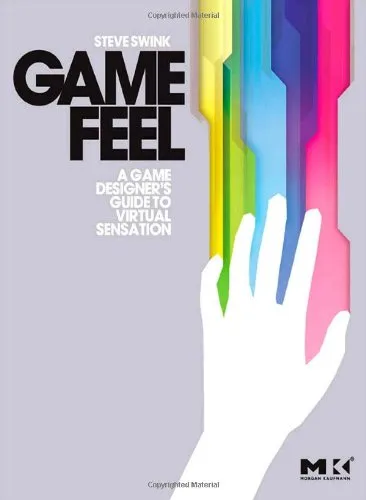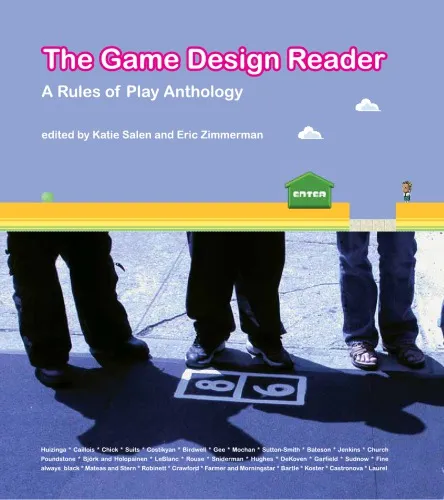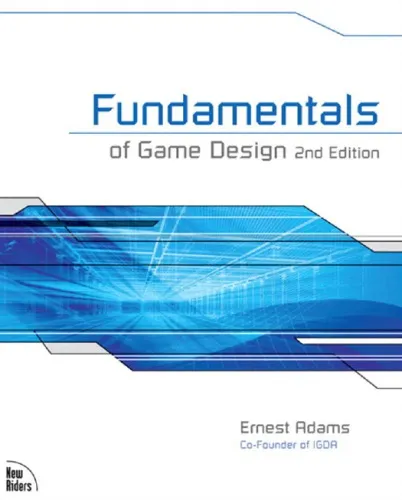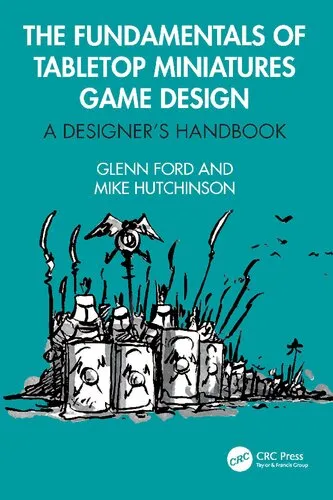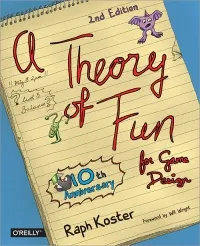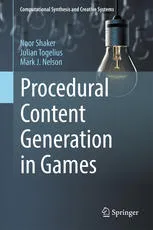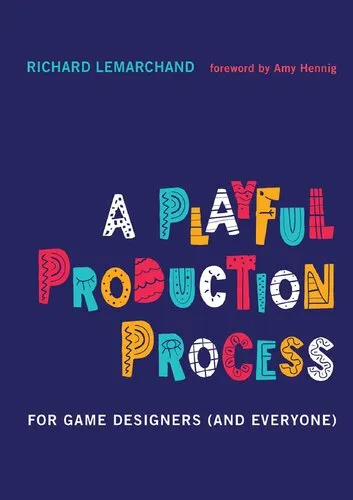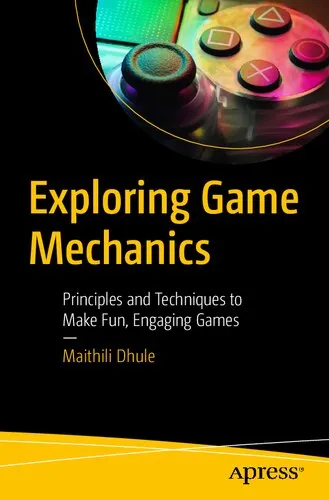Designing games: a guide to engineering experiences
4.0
بر اساس نظر کاربران

شما میتونید سوالاتتون در باره کتاب رو از هوش مصنوعیش بعد از ورود بپرسید
هر دانلود یا پرسش از هوش مصنوعی 2 امتیاز لازم دارد، برای بدست آوردن امتیاز رایگان، به صفحه ی راهنمای امتیازات سر بزنید و یک سری کار ارزشمند انجام بدینکتاب های مرتبط:
معرفی مفصل کتاب "Designing Games: A Guide to Engineering Experiences"
کتاب "Designing Games: A Guide to Engineering Experiences" نوشته تاینن سیلوستر، یکی از منابع مهم و جامع در زمینه طراحی بازیهای ویدیویی است که با ارائه راهنماهای عملی و نظری، به طراحان و توسعهدهندگان بازی کمک میکند تا تجربیات جذاب و منحصربهفردی برای بازیکنان خلق کنند.
خلاصهای از کتاب
این کتاب با بررسی مبانی طراحی بازیها شروع میشود و به تدریج به جزئیات پیچیدهتر و فنیتر پرداخته میشود. سیلوستر ابتدا به تحلیل مکانیزمها و قواعد اساسی میپردازد و سپس به مباحثی مانند تجربه کاربر، روایت داستان، و تعاملات اجتماعی در بازیها وارد میشود. این رویکرد جامع به طراحان بازی امکان میدهد که با دیدی کاملتر و عمیقتر به پروژههای خود بپردازند.
نکات کلیدی
- تجربه کاربری (UX) و اهمیت آن در تعامل بازیکن با بازی.
- روایت داستان و چگونگی ترکیب آن با مکانیکهای بازی.
- ملاحظات روانشناختی در طراحی بازیها و تاثیر آن بر رفتار بازیکنان.
- استفاده از دادهها و تحلیل بازخورد برای بهبود تجربه گیمینگ.
نکات مشهور کتاب
"یک بازی خوب، بازیکننده را وادار میکند تا خود را درگیر داستانی کند که از طریق آن، هیجان و چالش را درک کند."
"تعادل میان آزادی و قید در طراحی بازی، یکی از اساسیترین چالشها است که تاثیر مستقیمی بر جذابیت نهایی بازی دارد."
چرا این کتاب اهمیت دارد
کتاب "Designing Games" به دلیل جامعیت و جزییات فراوانی که در زمینه طراحی بازی ارائه میدهد، برای طراحان و توسعهدهندگان بازیها از اهمیت ویژهای برخوردار است. این کتاب نه تنها به اصول طراحی و مکانیزمهای بازی میپردازد، بلکه با نگاهی دقیق به جوانب انسانی و روانشناختی، درکی عمیقتر از نحوه تعامل بازیکنان با بازی فراهم میکند. علاوه بر این، با ارائه مثالهای واقعه از صنعت بازیسازی، به خوانندگان این امکان را میدهد تا نظریات مطرح شده در کتاب را به طور عملی در پروژههای خود بهکارگیرند.
Introduction
"Designing Games: A Guide to Engineering Experiences" by Tynan Sylvester is an essential text for anyone looking to delve into the intricate world of game design. This seminal work lays down foundational principles for crafting impactful gaming experiences, providing both theoretical insights and practical guidance. Whether you are a seasoned developer or an aspiring designer, Sylvester's wisdom offers a treasure trove of knowledge to enhance your craft.
Detailed Summary of the Book
The book seamlessly merges aspects of psychology, technology, and storytelling to illuminate the path of creating engaging games. Sylvester delves into the philosophy of game design, emphasizing the importance of player experience and narrative. The narrative approach ensures that designers can visualize the game from the player's perspective, optimizing it to satisfy and thrill.
Over its chapters, the book covers various crucial elements such as crafting game mechanics, understanding user feedback, and designing dynamic systems. Each section is dedicated to a specific facet of game development, offering a step-by-step exploration of complex processes such as emotion engineering and player motivation. Written with clarity and precision, this guide serves as a cornerstone for the development of engaging, challenging, and rewarding video games.
Key Takeaways
Sylvester provides numerous practical examples and real-world scenarios that provide a deeper understanding of game design complexity:
- Discover the importance of understanding player expectations and psychology in design decisions.
- Learn the significance of balancing game mechanics to maintain player interest and avoid frustration.
- Gain insights into storytelling within games—how to effectively weave narratives into interactive experiences.
- Understand the role of feedback loops in fine-tuning game mechanics and enhancing user engagement.
- Identify the technical and artistic challenges faced during game development and how to overcome them.
Famous Quotes from the Book
Sylvester's prose is both insightful and engaging, offering several quotable moments. Here are a few poignant passages:
"Games are not just about mechanics; they are about how those mechanics make players feel."
"Design is the art of generating experiences. The beautiful thing about game design is its ability to transcend the boundaries of traditional storytelling."
"Balancing a game is akin to tuning an instrument; it's precise, careful, and entirely necessary for harmony."
Why This Book Matters
In the ever-evolving landscape of the gaming industry, "Designing Games: A Guide to Engineering Experiences" provides a timeless framework that remains relevant amidst technological advancements. This book is more than a mere guide; it is a philosophy of game design that champions the player's experience. Sylvester's approach empowers designers to create games that are not just played but cherished and remembered.
By focusing on the fusion of lithe design processes with player-centered ideation, the book inspires both creativity and technical competence. It bridges the gap between the theoretical paradigms of design and their practical application, forming a comprehensive resource that drives innovation. In essence, this work is indispensable for those dedicated to mastering the art of creating bold and compelling digital worlds.
دانلود رایگان مستقیم
شما میتونید سوالاتتون در باره کتاب رو از هوش مصنوعیش بعد از ورود بپرسید
دسترسی به کتابها از طریق پلتفرمهای قانونی و کتابخانههای عمومی نه تنها از حقوق نویسندگان و ناشران حمایت میکند، بلکه به پایداری فرهنگ کتابخوانی نیز کمک میرساند. پیش از دانلود، لحظهای به بررسی این گزینهها فکر کنید.
این کتاب رو در پلتفرم های دیگه ببینید
WorldCat به شما کمک میکنه تا کتاب ها رو در کتابخانه های سراسر دنیا پیدا کنید
امتیازها، نظرات تخصصی و صحبت ها درباره کتاب را در Goodreads ببینید
کتابهای کمیاب یا دست دوم را در AbeBooks پیدا کنید و بخرید
1503
بازدید4.0
امتیاز51
نظر98%
رضایتنظرات:
4.0
بر اساس 1 نظر کاربران
"کیفیت چاپ عالی بود، خیلی راضیام"
ahmad44
20 اکتبر 2025، ساعت 17:03
The pursuit of understanding what makes a video game level truly memorable—not just functional, but magical—is the holy grail of game design. Alexander Crane’s "The Architecture of Fun: A Player-Centric Approach to Level Design" boldly steps into this arena, offering a comprehensive framework that is as intellectually rigorous as it is practical. While not without its minor flaws, the book establishes itself as an essential text for anyone serious about the craft.
A Foundation Built on Player Psychology
Crane’s greatest strength is his unwavering focus on the player. He argues convincingly that levels are not merely spaces for action but are psychological landscapes designed to evoke specific emotions and reactions. The book's first section is a masterclass in this regard, breaking down concepts like "Flow State," "Pacing of Challenge," and the "Cognitive Load of the Player" with remarkable clarity. He uses non-game analogies, such as comparing a well-paced level to a symphony, to ground abstract ideas in familiar experiences. This approach makes the book accessible to novices without ever feeling reductive for seasoned designers.
The "Player-Centric" methodology is the book's through-line. For every technique discussed—be it lighting, sound cues, or asset placement—Crane relentlessly asks, "What is the player feeling and thinking here?" This consistent reframing forces the reader to move beyond simply copying what worked in other games and to understand the why.
Questions & Answers
Ask questions about this book or help others by answering
No questions yet. Be the first to ask!



